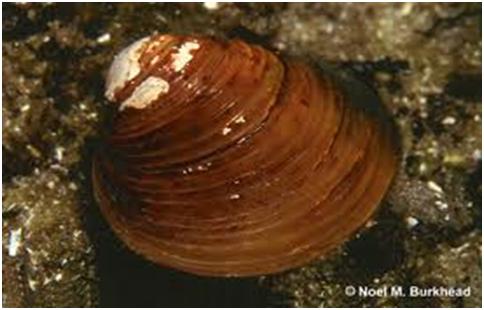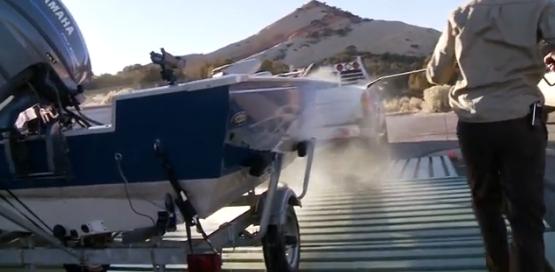UPCOMING EVENTS
View full calendarInvasive Species
WHAT ARE INVASIVE SPECIES?
Aquatic invasive species (AIS), also known as "nuisance" or "exotic" species, are non-native species that threaten the diversity or abundance of native species due to their rapid population growth, causing ecological or economic impacts. Invasive species often thrive in human-altered environments.
WHY CARE ABOUT AIS?
Invasive species are the second leading cause of species extinction and loss of biodiversity in aquatic habitats throughout the word. Single aquatic invasive species like Hydrilla, Carp, and Zebra Mussels, can crowd out entire communities of native species.
Aquatic invasive species also take an economic toll. Experts estimate that invasive zebra and quagga mussels cost power and water industries 5 billion dollars every year. Companies must pay to remove mussels from clogged filters, pipes, and water delivery systems.
AIS CAN:
- Displace or otherwise harm native species
- Alter ecosystem processes
- Reduce biodiversity
- Cause illnesses in animals and humans
- Cause severe economic impacts
- Reduce property values
SPECIFIC IMPACTS OF AIS
- Reduce fish populations
- Ruin boat engines
- Jam steering equipment
- Make lakes and rivers unusable for boaters and swimmers
- Increase operating costs of drinking water plants, power plants, dam maintenance, and industrial processes
- Reduce native species
- Degrade ecosystems
WATER QUALITY IMPACTS OF AIS
 Cheatgrass Bromus tectorum (shown above) covers millions of acres in the western United States. Cheat grass
burns easily and increases the risk of fires. This in turn increases fire-related
impacts on natural waters from heavily burned watersheds.
Cheatgrass Bromus tectorum (shown above) covers millions of acres in the western United States. Cheat grass
burns easily and increases the risk of fires. This in turn increases fire-related
impacts on natural waters from heavily burned watersheds.
 Common Carp Cyprinus carpio (shown above) feeds by searching through underwater vegetation. This feeding habit
uproots plants which muddies the water. This makes it hard for other fish to see and
destroys the food and cover for other fish.
Common Carp Cyprinus carpio (shown above) feeds by searching through underwater vegetation. This feeding habit
uproots plants which muddies the water. This makes it hard for other fish to see and
destroys the food and cover for other fish.
 Pepperweed Lepidium latifolium(shown above) invades riparian zones, salt marshes, and other habitats in the western United States. It can interfere
with the regeneration of cottonwoods and willow, which are two important native species
in western stream corridors.
Pepperweed Lepidium latifolium(shown above) invades riparian zones, salt marshes, and other habitats in the western United States. It can interfere
with the regeneration of cottonwoods and willow, which are two important native species
in western stream corridors.
HOW DO AIS SPREAD AND HOW TO STOP THEM?
Human activities play a large role in the spread of invasive species. Legal and illegal fish stocking, improper ship and boat maintenance, and improperly cleaned recreational or scientific equipment all contribute to the spread of invasive species. Below, find out what you can do to stop the spread of invasive species.
NATURAL BARRIERS TO AIS

- Geographic barriers - mountain ranges, oceans, wide rivers.
- Survival and establishment barriers - water temperature, pH, salinity.
SPREAD THE WORD NOT THE AIS
Prevention is the only proven way to control invasive species.
Once they are established, control of invasive species can be extremely difficult and expensive, if not impossible.By telling just one other person about the risks of aquatic invasive species, like a neighbor or friend, you can help raise awareness and protect our water.
Clean waders, footwear, fishing gear, and watercraft thoroughly via the steps above.
1) Rinse
2) Wash with 409, bleach, or lysol
3) Let thoroughly dry
Don't release aquarium fish, live bait, or other exotic animals or plants into the wild. If you plan on owning an exotic pet, please do your research before committing to take care of it.
When you are buying plants for your yard or garden make sure they are not invasive species. Replace invasive species with non-invasive plants or native plants. Contact your local nursery for more information.

 BOATS AND WATERCRAFTS
BOATS AND WATERCRAFTS
All you need to do is Clean, Drain, and Dry!
Clean any aquatic vegetation, mud and debris off of your boat and equipment.
Drain all of the water out of the boat (including live wells and ballast tanks). Make sure you lower the motor on your boat all the way in order to drain it. Leave hatches open to dry. Set anything that may have come in contact with the water out to dry (e.g., life jackets, ropes, anchors, inflatable toys).
Dry your boat for at least:
- 7 days in the summer
- 18 days in the fall or spring
- 30 days in winter or 3 consecutive days below freezing
OR
Don't want to wait that long? Have a professional decontamination done. Professional decontamination uses 140 degree water with no soaps or chemicals. To find a professional decontamination station near you call:
Northern Utah 801-648-6315
Northeastern Utah 435-790-8938
Central Utah 435-503-4066
Southern Utah 435-691-2427
Southeastern Utah 435-630-3132
WANT MORE INFORMATION?
Aquatic Invasion! (lesson plan for 6th-10th graders)
Utah Invasive Species List (Feb. 2011)
